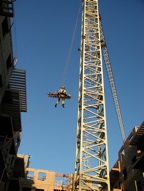Rope Rescue: NFPA 1670 - Awareness Level (RX-AL)
Prerequisite: None.
Duration: Three hours.
This multi-media, open discussion presentation covers all of the requirements needed to bring one’s agency into Awareness Level compliance with Chapter 4 of NFPA’s 1670 standard for rope rescue. This information allows all department members to safely assist the technical rescue team at the scene of a rescue.

Rope Rescue: NFPA 1670 - Operations Level Skills (RX-OLS)
Prerequisite: None.
Duration: Three days.
Based upon their response district, some agencies do not need all of the skills required to operate at the Technician Level. Other agencies utilize a small Technician team and provide support from Operations Level personnel. Regardless of which model the agency uses, RX-OLS will provide the needed skills and concepts to meet the requirements outlined by the NFPA.
Rope Rescue: NFPA 1670/1006 - Technician Level Skills (RX-TLS)
Prerequisite: None.
Duration: Six to Eight days (depending the client's training needs).
RX-TLS not only meets all of the Technician Level requirements as outlined in NFPA 1670, it also meets all of the requirements for the Rope Rescue Technician (Professional Qualifications) outlined in NFPA 1006, Chapter 4. RX-TLS is based on a streamlined format that allows the agency to meet all of the NFPA requirements in a relatively short, but intensive period of time without sacrificing safety or efficiency. Team-based rescue operations is the primary focus of this course.
NOTE ON RX-OLS and TLS: In the rope rescue world, there are many methods available to accomplish the same task. For the NFPA 1670 programs, we have selected what we believe to be those skills that are the safest, simplest and easiest to remember. While we at HRT support NFPA 1670 and 1006, we feel that the "NFPA Technician Level" skills represent the MINIMUM STANDARD for working in the rope rescue arena and that teams and individuals that respond to rope-based rescues should pursue further, more advanced training.
Rope Rescue: Industrial/Structural - Level I and Level II (RX-IND - Levels I & II)

Duration: Four to Five days each level (depending the client's training needs).
RX-IND was specifically created for our industrial clients. The training, techniques and systems mesh perfectly with the industrial team’s operating environment. Refineries, steel mills, power plants and other unique facilities require a special type of structural rigging and rescue techniques. Further, most industries are required to follow certain OSHA regulations during training and actual rescues. Our industrial training program will cover these regulations in depth and will also bring any in-plant rescue team up to an NFPA Technician Level using proven training methods and techniques designed specifically for the unique industrial environment.
NOTE ON RX-IND- Levels I & II: Combine these courses with Confined Space: Industrial Entry and Rescue for a complete program to meet the rescue requirements outlined in OSHA’s 29 CFR 1910.146, Paragraph K and Appendix F











